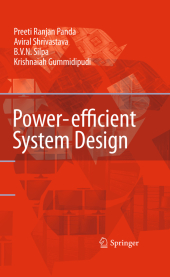 Neuerscheinungen 2014Stand: 2020-02-01 |
Schnellsuche
ISBN/Stichwort/Autor
|
Herderstraße 10
10625 Berlin
Tel.: 030 315 714 16
Fax 030 315 714 14
info@buchspektrum.de |

Preeti Ranjan Panda, Aviral Shrivastava, B. V. N. Silpa
(Beteiligte)
Power-efficient System Design
2010. 2014. x, 253 S. 235 mm
Verlag/Jahr: SPRINGER, BERLIN; SPRINGER US; SPRINGER 2014
ISBN: 1-489-97352-4 (1489973524)
Neue ISBN: 978-1-489-97352-8 (9781489973528)
Preis und Lieferzeit: Bitte klicken
This book addresses power optimization in modern electronic and computer systems. Exploring power optimization opportunities and their exploitation at various levels of abstraction, it is intended for students, researchers, and practitioners alike.
The Information and communication technology (ICT) industry is said to account for 2% of the worldwide carbon emissions - a fraction that continues to grow with the relentless push for more and more sophisticated computing equipment, c- munications infrastructure, and mobile devices. While computers evolved in the directionofhigherandhigherperformanceformostofthelatterhalfofthe20thc- tury, the late 1990´s and early 2000´ssaw a new emergingfundamentalconcern that has begun to shape our day-to-day thinking in system design - power dissipation. As we elaborate in Chapter 1, a variety of factors colluded to raise power-ef?ciency as a ?rst class design concern in the designer´s mind, with profound consequences all over the ?eld: semiconductor process design, circuit design, design automation tools, system and application software, all the way to large data centers. Power-ef?cient System Design originated from a desire to capture and highlight the exciting developments in the rapidly evolving ?eld of power and energy op- mization in electronic and computer based systems. Tremendous progress has been made in the last two decades, and the topic continues to be a fascinating research area. To develop a clearer focus, we have concentrated on the relatively higher level of design abstraction that is loosely called the system level. In addition to the ext- sive coverage of traditional power reduction targets such as CPU and memory, the book is distinguished by detailed coverage of relatively modern power optimization ideas focussing on components such as compilers, operating systems, servers, data centers, and graphics processors.
Low Power Design: An Introduction.- Basic Low Power Digital Design.- Power-efficient Processor Architecture.- Power-efficient Memory and Cache.- Power Aware Operating Systems, Compilers, and Application Software.- Power Issues in Servers and Data Centers.- Low Power Graphics Processors.
Aus den Rezensionen:
"... Dieses Buch ist dem lobenswerten Ziel gewidmet ... Die Autoren sind ehrlich genug, die effektiven Motivationen für die Entwicklung energeeffezienter ICT Produkte aufzuführen. ... Das an Studierende, Forscher und Entwicklungsingenieure gerichtete Buch ... Ein gutes Buch mit ausgewogener Beschreibungstiefe, das die Grundlagen der Stromsparmassnahmen bei ICT Systemen umfassed vermittelt. Eine sehr empfehlenswert Lekture."(in: Bulletin SEV/VSE, 1/July/2011, Issue 7, S. 71)


